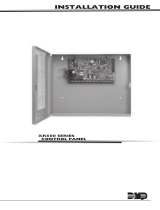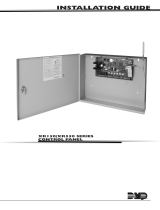
2W-BLX AND 2WT-BLX INSTALLATION GUIDE | DIGITAL MONITORING PRODUCTS 3
ADDITIONAL INFORMATION
Location Advice
Consult the Local Authority Having Jurisdiction (AHJ) and NFPA 72 for specific installation information about smoke
detector spacing, placement, location, and special applications.
Maintenance and Cleaning
This detector must be tested and maintained regularly following NFPA 72 requirements. At a minimum, cleaning should
be performed annually.
Before performing maintenance on the detector, notify the proper authorities that maintenance is being performed
and the system will be temporarily out of service. Disable the circuit undergoing maintenance to prevent any unwanted
alarms. Power must be removed from the detector before performing maintenance of any kind.
Figure 7: 2W-BLX/2WT-BLX
Exploded View
Removable
Detector
Cover
Screen/Sensing
Chamber
(Top Half)
Detector
Housing
1. Remove the detector cover by turning counterclockwise.
2. Vacuum the cover or use canned air to remove any dust or
debris.
3. Remove the top half of the screen/sensing chamber by
lifting straight up (See Figure 7.)
4. Vacuum or use canned air to remove any dust particles that
are present on both chamber halves.
5. Replace the top half of the screen/sensing chamber by
aligning the arrow on the screen/sensing chamber with the
arrow on the housing. Press down firmly until the screen/
sensing chamber is fully seated.
6. Replace the detector cover by placing it over the screen/
sensing chamber and turning it clockwise until it snaps into
place.
7. Reinstall the detector and test. (See Test the Detector.)
Wiring Specifications
When planning an LX-Bus installation, keep in mind the following specifications:
1. DMP recommends using 18-gauge unshielded wire for all LX-Bus circuits. Do Not use twisted pair or shielded wire
for LX-Bus circuits. To maintain auxiliary power integrity when using 18-gauge wire do not exceed 1,000 feet. To
increase the wire length or to add devices, install an additional power supply.
2. Maximum distance for any one circuit (length of wire) is 2,500 feet regardless of the wire gauge. This distance can
be in the form of one long wire run or multiple branches with all wiring totaling no more than 2,500 feet. As wire
distance from the panel increases, DC voltage on the wire decreases.
3. Maximum number of devices per 2,500 feet circuit is 40.
4. Maximum voltage drop between the panel (or auxiliary power supply) and any device is 2.0 VDC. If the voltage at
any device is less than the required level, add an auxiliary power supply at the end of the circuit. When voltage is
too low, the devices cannot operate properly.
For additional information refer to the 710 Installation Sheet (LT-0310) and/or the LX-Bus/Keypad Bus Wiring
Application Note (LT-2031).
Single Point Addressable
A factory-mounted, addressable single-point zone expander is integrated in the base of the smoke detector. The
included 4-wire harness allows a direct connection to the LX-Bus of XR150/XR550 Series panels. The integrated zone
expander reports to the panel as a single zone. See Addressing the 2W-BLX and 2WT-BLX.
A Green LED is included on the integrated zone expander PCB which flashes every 2 seconds to confirm device polling.
Fixed Temperature Thermal Detector
The Model 2WT-BLX features a restorable, built-in, fixed temperature thermal detector and is capable of sensing a
temperature higher than 135°F. If the detector senses a higher temperature than 135 °F, the Red LED latches on, and an
alarm condition is sent to the control panel.









